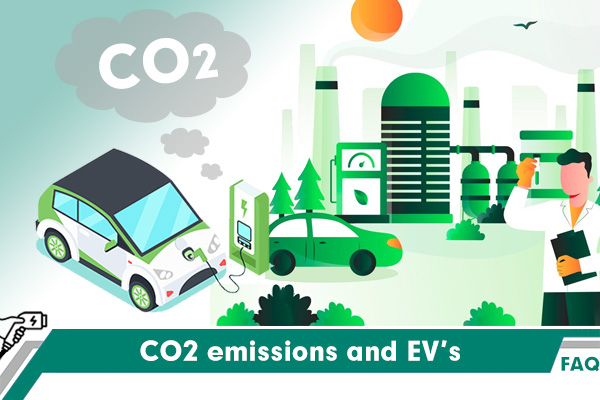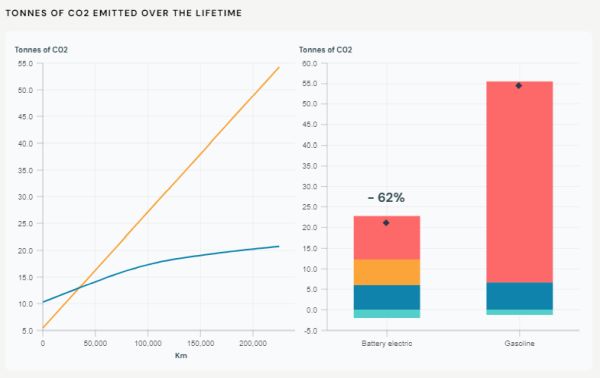
Manufacturing an Electric Car produces a lot more CO2 emissions than a Gasoline car. Is that true or false? Let’s dive into it.
A lot of debate is going on, especially on social media, about the manufacturing process of Electric Cars and the corresponding CO2 emissions. Stating that manufacturing an Electric Car will produce a lot more CO2 emissions than manufacturing a gasoline car. First of all, thàt statement is true, but there is more to it.
Although electric cars’ batteries make them more carbon-intensive to manufacture than gasoline cars, they more than make up for it by driving much cleaner under nearly any conditions.
To correctly compare the carbon print of an EV (Electric Vehicle) Car to an ICE (Internal Combustion Engine) car, you need to look at the entire life-cycle of the car. From manufacturing, to driving, to decommissioning the car. It is true that there will be a much higher carbon print to produce an electric car. Especially the manufacturing of the battery is responsible for the high carbon print. However, after manufacturing the EV, it will produce much less CO2 compared to ICE cars while driving. Also, did you know that the lithium-ion battery is about 95% recyclable which also contributes to lower CO2 emissions on the long run?
Where is CO2 emission produced?
Gasoline Cars
- The manufacturing process involves the production of various components such as engine blocks, transmissions, exhaust systems, and fuel systems.
– CO2 emissions are generated during the extraction of raw materials, manufacturing of components, assembly of the vehicle, and transportation of parts to assembly plants.
– Additionally, energy-intensive processes like casting, forging, machining, and painting contribute to CO2 emissions. - Gasoline cars produce CO2 emissions directly through the combustion of fossil fuels (gasoline or diesel) in their internal combustion engines.
- The burning of gasoline releases carbon dioxide (CO2) and other greenhouse gases into the atmosphere, contributing to climate change and air pollution.
- The older the car, the greater the emissions due to the wear and tear of the engineblock.
- Additionally, gasoline cars emit other pollutants such as nitrogen oxides (NOx), carbon monoxide (CO), and particulate matter (PM), which have adverse effects on air quality and human health.
Electric Cars
- he manufacturing process involves the production of various components such as electric motors, batteries, power electronics, and associated systems.
– The manufacturing of batteries, in particular, is energy-intensive and can generate significant CO2 emissions.
– CO2 emissions are also produced during the manufacturing of other components and assembly of the vehicle.
– There are less parts needed than an ICE car (no engine block / no transmission / and so on.) - Electric cars produce zero tailpipe emissions since they are powered by electric motors that run on electricity stored in batteries.
- However, CO2 emissions associated with electric cars occur during the electricity generation process, depending on the sources of electricity used for charging.
- If electricity comes from renewable sources such as wind, solar, or hydroelectric power, electric cars can have very low or even zero net CO2 emissions over their lifecycle.
- On the other hand, if electricity is generated from fossil fuels like coal or natural gas, electric cars may indirectly contribute to CO2 emissions, albeit at a lower rate compared to gasoline cars. Particulate matter (PM) in that case still remains minimal because PM is filtered out at the electricity plants.
The EV Battery Production
- Building an 80 kWh lithium-ion battery creates between 2.5 and 16 metric tons of CO2. Depending on what energy source is used in the production process.
One source of EV emissions is the creation of the large lithium-ion batteries which are needed in an Electric Car. The use of minerals including lithium, cobalt, and nickel, which are crucial for modern EV batteries, requires using fossil fuels to mine those materials and heat them to high temperatures. To synthesize the materials needed for production, heat between 800 to 1000 degrees Celsius is needed—a temperature that can only cost-effectively be reached by burning fossil fuels, which again adds to CO2 emissions.
Most lithium-ion batteries are manufactured in China, where coal is the primary energy source. (Coal emits roughly twice the amount of greenhouse gases as natural gas, another fossil fuel that can be used in high-heat manufacturing.) As a result, building an 80 kWh lithium-ion battery creates between 2.5 and 16 metric tons of CO2 (exactly how much depends greatly on what energy source is used to do the heating). (Source)
Battery materials come with other costs, too. Mining raw materials like lithium, cobalt, and nickel is labor-intensive, requires chemicals and enormous amounts of water—frequently from areas where water is scarce—and can leave contaminants and toxic waste behind. 60% of the world’s cobalt comes from the Democratic Republic of the Congo, where questions about human rights violations such as child labor continue to arise.
Although this is never ok, please also be aware of the environmental and human impact of the oil industry as well. The toxic waste, environmental oil-spill disasters, transporting oil (oil vessels), the oil winning process, all the wars fought over oil, and so on. You cannot state the impact of the battery production, while disregarding the impact of the oil industry.
Some Values

To give you some idea, let’s look at the table with some average CO2 emission values:
CO2 emission to manufacture an ICE car: 6,7 metric tons of CO2
CO2 emission to drive an ICE car: 48,9 metric tons of CO2
Recycling an ICE car: A profit of – 1,3 metric tons of CO2
Total CO2 emissions during entire lifespan: 54,3 metric tons of CO2
CO2 emission to manufacture an EV car: 6 metric tons of CO2
CO2 emission to manufacture an EV battery: 6,3 metric tons of CO2
CO2 emission to drive an EV car: 10,5 metric tons of CO2 (grey electric source)
Recycling an EV car: A profit of – 2 metric tons of CO2
Total CO2 emissions during entire lifespan: 20,8 metric tons of CO2
On the line-graph:
The blue line is the CO2 emission of an EV car during its life-span.
The yellow line is the CO2 emission of an ICE car during its life-span.
Source: Transportenviroment.org
A small calculation
Building an 80 kWh lithium-ion battery creates between 2.5 and 16 metric tons of CO2.
How much is one metric ton of CO2? As much as a typical gas-powered car emits in about 4000 km of driving.
2.5 metric tons of CO2 X 4000 km of driving = 10.000 km of driving to even out the CO2 emissions for producing the battery in the best-case scenario.
or
16 metric tons of CO2 X 4000 km of driving = 64.000 km of driving to even out the CO2 emissions for producing the battery in the worst-case scenario.
So, the turning point where an EV becomes cleaner is after 10.000km driving, if the battery was manufactured using the greenest production method. Or up to 64.000km if the battery was manufactured using the ‘dirtiest’ production method. It sounds like a lot, but that 64.000km will in most cases be reached in about 3-4 years. After this turning point, the EV will produce almost zero CO2 emissions while the ICE car will still be burning fossil fuels.
Granted; this is actually a too easy representation as extensive calculations will also take into account the CO2 used by powerplants to produce electricity, needed to power an EV. And the CO2 emission of gasoline cars will get higher as the car gets older. But that is a difficult calculation which is region dependent. On Curacao we will get more and more solar- and windpower which will massively decrease the carbon footprint. Also, a lot of Curacao EV drivers have home-solar power.
Conclusion
On any case, even in the worst-case scenarios (where coal is used to power electricity plants, which in turn power the EV) all studies reveal that an Electric Car will almost always produce at least 50% less CO2 emissions than an ICE car during its entire lifespan. The only scenario this will not be the case is when you leave the EV in the garage and drive very little kilometers with it. So even with the high carbon print of producing the battery, it is still much better for the environment to drive an Electric Car.
Additionally, around 2030 it is expected that the mainstream Lithium-Ion batteries will be replaced with the much more environmentally friendly LPF (Lithium iron phosphate) battery. Although LFP has a lower energy density, it is cheaper to produce, requires less controversial raw materials, such as cobalt, and therefore has a lower environmental impact.
Not only will it drastically decrease the carbon print during the production of EV batteries, but also the life-span of these batteries is much better than the life-span of the Lithium-Ion batteries. (source in Dutch)
Some sources
- https://climate.mit.edu/ask-mit/are-electric-vehicles-definitely-better-climate-gas-powered-car
- https://climate.mit.edu/ask-mit/how-much-co2-emitted-manufacturing-batteries
- CO2 emissions from gas cars outweigh electric, even with battery manufacturing | Fact check (msn.com)
- PolitiFact | CO2 output from making an electric car battery isn’t equal to driving a gasoline car for 8 years
